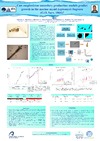Please use this identifier to cite or link to this item:
https://accedacris.ulpgc.es/jspui/handle/10553/16354
| DC Field | Value | Language |
|---|---|---|
| dc.contributor.author | Marrero, Alejandro | en_US |
| dc.contributor.author | Martínez, Ico | en_US |
| dc.contributor.author | Herrera-Ulibarri, Alicia | en_US |
| dc.contributor.author | Gómez, May | en_US |
| dc.contributor.author | Tames-Espinosa, Mayte | en_US |
| dc.contributor.author | Packard, Theodore T | en_US |
| dc.date.accessioned | 2016-04-06T09:08:20Z | - |
| dc.date.accessioned | 2018-06-15T09:22:53Z | - |
| dc.date.available | 2016-04-06T09:08:20Z | - |
| dc.date.available | 2018-06-15T09:22:53Z | - |
| dc.date.issued | 2016 | en_US |
| dc.identifier.uri | https://accedacris.ulpgc.es/handle/10553/16354 | - |
| dc.description.abstract | Zooplankton growth and secondary production are key input parameters in marine ecosystem models, but their direct measurement is difficult to make. Accordingly, zooplanktologists have developed several statistical-based secondary production models. Here, three of these secondary production models are tested in the marine mysid Leptomysis lingvura (Mysidacea, Crustacea). Mysid length was measured in two cultures twice a day, which were grown on two different food concentrations. Growth rates ranged from 0.11 to 0.64 day-1, while secondary production rates ranged from 1.77 to 12.23 mg dry- mass day-1. None of the three selected models were good predictors of growth and secondary production in this mysid species. | es |
| dc.language | eng | en_US |
| dc.subject | 241705 Biología marina | es |
| dc.subject | 251001 Oceanografía biológica | es |
| dc.subject.other | Secondary production | es |
| dc.subject.other | Growth rate | es |
| dc.subject.other | Mysid | es |
| dc.subject.other | Dry-mass | es |
| dc.title | Can zooplankton secondary production models predict growth in the marine mysid Leptomysis lingvura (G.O. Sars, 1866)? | en_US |
| dc.type | info:eu-repo/semantics/conferenceobject | en_US |
| dc.type | Conference poster | en_US |
| dc.investigacion | Ciencias | es |
| dc.project.acronym | BIOMBA | - |
| dc.project.end | 2015-12-31 | - |
| dc.project.reference | CTM2012-32729 | - |
| dc.project.scope | Estatal | - |
| dc.project.sponsorship | Ministerio de Economía y Competitividad | - |
| dc.project.start | 2013-01-01 | - |
| dc.project.title | Metabolismo planctónico: regulación bioquímica e impacto oceanográfico | - |
| dc.project.type | Proyecto | - |
| dc.project.type | Investigación | - |
| dc.rights.accessrights | info:eu-repo/semantics/openAccess | es |
| dc.type2 | Póster de congresos | en_US |
| dc.identifier.ulpgc | Sí | es |
| item.grantfulltext | open | - |
| item.fulltext | Con texto completo | - |
| crisitem.author.dept | GIR ECOAQUA: Ecofisiología de Organismos Marinos | - |
| crisitem.author.dept | IU de Investigación en Acuicultura Sostenible y Ec | - |
| crisitem.author.dept | GIR ECOAQUA: Ecofisiología de Organismos Marinos | - |
| crisitem.author.dept | IU de Investigación en Acuicultura Sostenible y Ec | - |
| crisitem.author.dept | Departamento de Biología | - |
| crisitem.author.dept | GIR ECOAQUA: Ecofisiología de Organismos Marinos | - |
| crisitem.author.dept | IU de Investigación en Acuicultura Sostenible y Ec | - |
| crisitem.author.dept | Departamento de Biología | - |
| crisitem.author.orcid | 0000-0002-7676-2066 | - |
| crisitem.author.orcid | 0000-0002-5538-6161 | - |
| crisitem.author.orcid | 0000-0002-7396-6493 | - |
| crisitem.author.orcid | 0000-0003-0607-5321 | - |
| crisitem.author.parentorg | IU de Investigación en Acuicultura Sostenible y Ec | - |
| crisitem.author.parentorg | IU de Investigación en Acuicultura Sostenible y Ec | - |
| crisitem.author.parentorg | IU de Investigación en Acuicultura Sostenible y Ec | - |
| crisitem.author.fullName | Martínez Sánchez, Ico | - |
| crisitem.author.fullName | Herrera Ulibarri, Alicia Andrea | - |
| crisitem.author.fullName | Gómez Cabrera, María Milagrosa | - |
| crisitem.author.fullName | Tames Espinosa, Maria Teresa | - |
| Appears in Collections: | Póster de congreso | |
Page view(s)
59
checked on Jan 27, 2024
Download(s)
32
checked on Jan 27, 2024
Google ScholarTM
Check
Share
Export metadata
This item is licensed under a Creative Commons License

